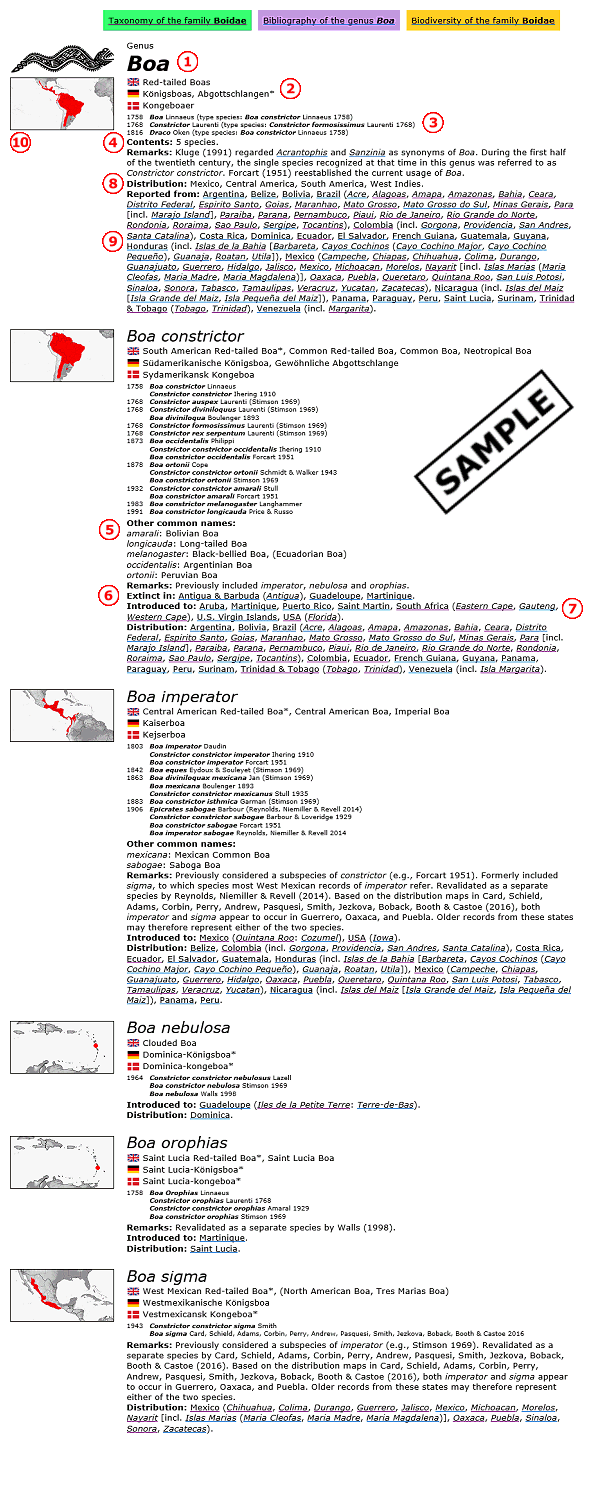
|
The
Taxonomy section presents each of the main groups of reptiles
(lizards, snakes, turtles, worm lizards, crocodilians, and the tuatara), each family, and each genus, as well as the class of reptiles in general.
Within each family, the genera are listed alphabetically, and within each genus, the species are listed alphabetically.
Each page roughly follows the same format, which, whenever relevant, includes the information listed below.
- Scientific (Latin) name:
The current scientific name is listed.
In controversial cases, a conservative standpoint is likely to have been taken.
Whenever relevant, a remark has been made regarding existing taxonomical or nomenclatural controversies.
Common name(s) in English, German, and Danish:
The intention has been to include most published names, however, the list is undoubtedly incomplete.
Some degree of harmonization* has been attempted.
Certain names are given in parentheses.
It is recommended that these names are avoided, either because they may lead to confusion with other species or because they are
patronyms, matronyms, or eponyms*, the use of which is discouraged.
In the case of species which have had no common name, a new name* has been proposed.
Synonymies and subspecies:
All subspecies (valid or not) and most synonyms have been included, with the exception of some unavailable names, nomina nuda, nomina oblita, etc.
The synonyms are listed chronologically, and each synonym is followed by the various combinations in which it has appeared.
Only the first use (to the author's knowledge) of each combination is listed, however, omissions are bound to occur in a synonymy of this magnitude, particularly regarding combinations which have been out of use for more than a century.
Additions and corrections must be expected to appear over time.
Spelling variations (typos, etc.) are generally not included.
Contents:
Summarizes the number of species, genera, and/or families, wherever relevant.
Other common names:
Includes English common names which have been used for subspecies or synonyms.
As opposed to some other lists, a subspecific name which is identical to the name of the species, is not accepted, as it might cause confusion.
In such cases, a modification has been suggested.
Extinct in:
Includes previous occurrences of the taxon, which have now vanished.
Introduced to:
This paragraph lists the non-native distribution (if any) of the species, i.e. countries and regions where the occurrence is based on an introduction.
This includes both deliberate and accidental introductions, regardless of the number of specimens reported and whether the species has established a reproducing population or not.
If a species is assumed to have been introduced, it is regarded herein as such.
If it is unclear whether a species occurs naturally or has been introduced, the distribution will be considered part of the native range.
Distribution (text):
Describes the native distribution of the species, genus, or higher category, country by country. In the case of widespread species, only the general distribution is
given under this paragraph (but see below).
Reported from:
In cases of widely distributed species, genera or other groups, the distribution is given in detail under this paragraph.
Currently, this includes all countries and many states, provinces, archipelagos, islands, etc.
For some countries the distribution described is complete (with respect to the level of detail used herein), for other countries it may still be selective,
with more accurate descriptions in preparation for future editions of RepFocus.
If a distribution record is on the border between two countries or regions, the species is listed for both.
Distribution (maps):
At the left margin, thumbnail maps (160x80 pixels) link to pages with larger maps (1000x500 pixels).
Maps have only been prepared for about 24% of the world's species, but cover all genera and higher taxonomical categories, although half of the genera are only
provided with outline maps in this 1st edition of RepFocus.
In forthcoming editions, it is the plan to add more maps, with first priority given to medically important (venomous) species, second priority to recently described
or revised species, or other species for which distribution maps are not readily available in the main literature, and third priority to genera and species from
regions which are covered by existing field guides, handbooks, etc. which include maps.
|








